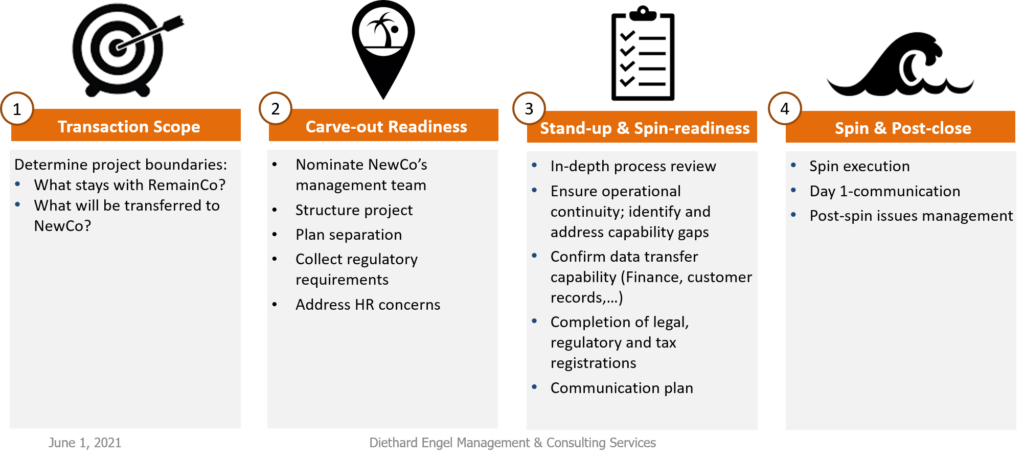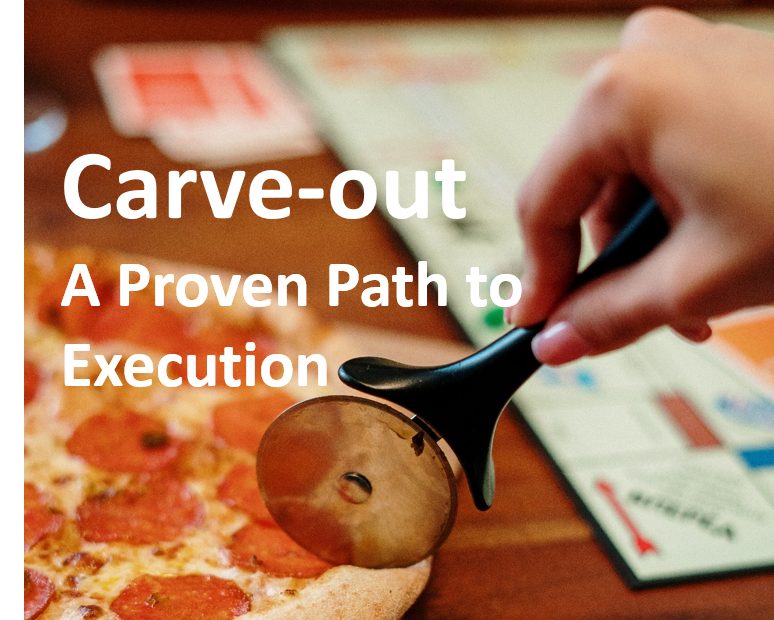Various reasons, from cash generation to meeting anti-trust requirements, can lead to a carve-scenario. Only: A carve-out does not just happen – it needs to be planned meticulously.
Once the strategic decision for a carve-out has been taken, planning commences: Target buyers need to be identified; competing priorities like execution speed, value and quality need to be balanced. From a purely operational point of view, however, there are a couple of steps which will lead the program manager through the schedule, depicted in the illustration below:

Initially, the boundaries of the business that shall be carved out need to be set: Locations, functions, products and services, and/or people are key determinants. In a next step, the carve-out leadership team has to be nominated. At times, not all functional management positions required for the new business can be filled from within. Given the time constraints of such a project, interim management can be a resourcing option if immediate external recruitment is not feasible. Just like in any other strategic project, the carve-out team needs to take shape, and the project should be structured into an execution team (functional management plus support team) and a steering group. Timing and objective of the carve-out should be set, as should the project governance (decision making processes, conflict & priority management, resourcing….).
People are the heart of any business, and people concerns need addressing early on. HR plays an important role throughout the project execution cycle, and should be staffed adequately. Change management know-how helps, together with a good communication plan for internal and external addressees (communication, however, is certainly not solely a HR task).
In the next step, the new business‘ operational readiness becomes the focal point: Functional processes should be reviewed and listed, including any interfaces with adjacent functions and hand-over points. Transitional/Temporary service agreements (TSA) should be prepared for those functions and processes which will not carry over into the new entity. Any capability gaps (functionally and resource-wise) need to be identified and addressed, either through TSAs, external services, or internal capability build. Furthermore, the new company need to be registered (court of commerce, tax, any other regulatory bodies).
IT and Business Systems represent a relatively large risk: Systems may be sustained, separated, relieved, and data potentially transferred, adapted, changed, deleted. Data and systems are key components in a spin-readiness assessment.
Eventually, Day 1 is going to be there. I have yet to see a spin that would take place without any issues: There is always something that was forgotten, that goes wrong or at least not as planned. The carve-out team should be set up for some post-spin issues management. Some issues only surface with delay, during a closing cycle, for example. Continuous monitoring of systems and detection of unusual process behavior are crucial in this stage.
While the above describes some common steps and activities, all carve-outs are different: Differently sized, different complexity, different people. There is no one-size-fits-all approach, and there is no predetermined timeline either. I recommend developing the detailed program in a reconnaissance phase together with Management. As a side effect, this also triggers early Management involvement. Getting Management buy-in to the approach, a commitment to objectives and eventually the timeline is crucial for a high caliber project like a carve-out in any case.
Carve-outs are predominantly transformation and change programs. My recommendation would be to look for a project manager with relevant transformation experience, rather than look for an industry insider lacking the project and process management know-how.
